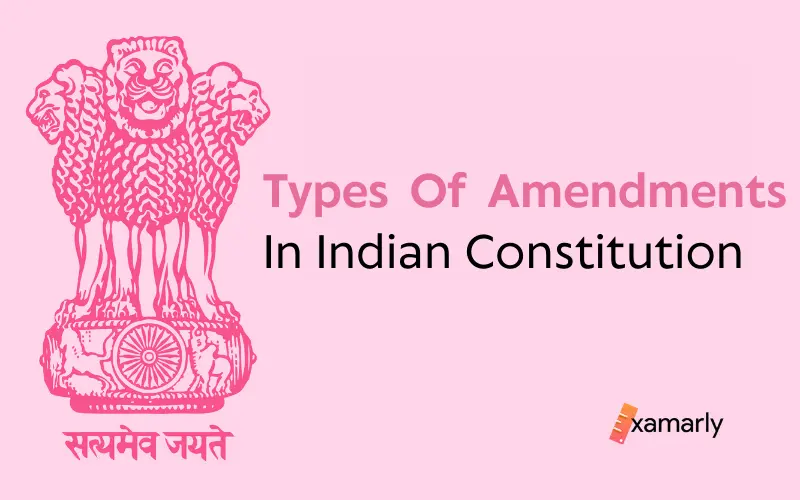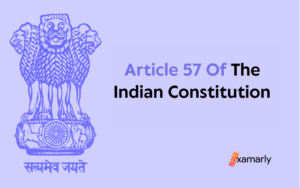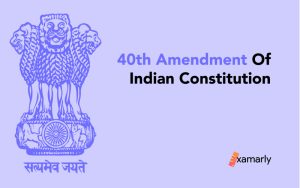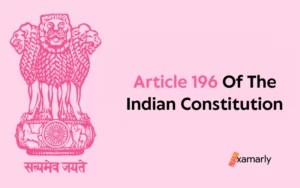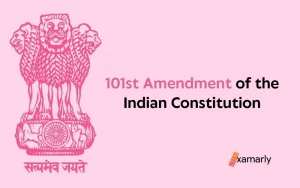The “Rule of Law” is set forth by the constitution, which stands for freedom from irrational, unfair, and unjust laws, equality before the law, and the lack of arbitrary authorities.
The process of altering the nation’s fundamental law or supreme law is referred to as amending the constitution. Constitutional provisions Part XX (Article 368) of the constitution of India enlightens the strategy of its amendment, which secures the sanctity of the Constitution while keeping a check on the arbitrary power of the Indian Parliament.
There are basically three types of amendments in Indian Constitution. The essential features of these amendments may increase or decrease Parliament’s number of seats or eliminate certain seats. In some cases, an amendment can be passed with a simple majority or special majority.
This article focuses on the types of Amendments in Indian Constitution. This important article is worth reading if you are preparing for competitive exams like UPSC CSE Exam. It is a part of the UPSC Syllabus covered under Indian Polity.
- Amendment Of Indian Constitution
- The Amendment Procedure
- Types Of Amendments In Indian Constitution
- A Simple Majority Of Parliament
- Special Majority Of The Parliament
- Special Majority In Parliament Along With State Consent
- Examples Of Constitutional Amendments
- Article 368 Indian Constitution
- Types Of Special majority of the Parliament
- “Article 249” of the special majority
- “Article 368” of the special majority
- “Article 368” plus the ratification of the state
- “Article 61” of the special majority
- Conclusion
Amendment Of Indian Constitution
The constitutional amendment procedure reflects the desire of the constituent legislative assembly to put in place a dynamic document (i.e. the Constitution of India) that provides various amending procedures with flexibility and rigidity, without harming the basic structure of the constitution.
The Constitution of India allows the Parliament to amend it by a formal method if it so desires. The Constitution can only be amended by Parliament if it is approved by a majority of members of the Lok Sabha and other Houses.
The procedure to introduce a Constitution Amendment Bill in either House of Parliament is simple. It can be initiated in either House of Parliament, or by a private member. It is rejected if the bill is not passed by both Houses.
To learn more about the Amendment Of Indian Constitution and Basic Structure Theory, explore the linked article.
The Amendment Procedure
The amendment procedure of Indian Constitution has evolved with the times. It is no longer in a written format, but it still serves the same purpose. According to Article 368, the process for changing the Constitution is as follows:
- First, a bill proposing an amendment must be submitted to either House of Parliament, not to state legislatures.
- A minimum of two-thirds of the members of both houses of the Parliament must vote in favor of the Bill for it to become law.
- After both houses have passed the bill, it is presented to President who must give his approval to the proposed amendment.
- Once the President has approved the proposed amendment, it becomes law.
Article 368 of the Indian Constitution describes the core amendment rules of procedure for amending its constitution, by providing information about the powers and procedures for amending the constitution. This process is designed to preserve the Constitution’s integrity, prevent Parliament from exercising arbitrary powers, and deal with the power of parliament to amend.
Types Of Amendments In Indian Constitution
An amendment to the Constitution can be implemented by initiating a bill in either House of Parliament, while not in the state legislatures. A minister or a private member can deliver a bill, without any prior approval from the president. The amendments can be done in three ways–
- Amendment by a simple majority of the Parliament
- Amendment by a special majority of the Parliament
- Amendment by a special majority of the Parliament along with the ratification of at least half of the state legislatures.
The first type can be passed with a simple majority in either of the houses of Parliament. The second and third types must be ratified by the state legislatures. These amendments are made to change specific provisions of the Constitution. The process begins with a bill before Parliament. This bill must then be approved by two-thirds of the members. A bill that is approved, becomes an act for a constitutional amendment.
A Simple Majority Of Parliament
Instances of the Constitution that fall beyond the purview of Article 368 can be altered by a simple majority of the two houses of Parliament. Some of the provisions include the following:
- Salaries and allowances of the members of Parliament
- Rules of procedure in Parliament
- creation of new states and changes to the names, regions, or boundaries of the current state
- Quorum in Parliament
- Privileges of the Parliament, its members, and its committees
- Use of English language in Parliament
- Abolition or creation of legislative councils in states
- Number of puisne judges (denoting a judge of a superior court inferior in rank to chief justices) in the Supreme Court
- Conferment of more jurisdictions on the Supreme Court
- Use of official language
- Delimitation of constituencies
- Union territories
- Citizenship – acquisition, and termination
- Elections to Parliament and state legislatures
- Fifth Schedule – scheduled areas and STs administration
- Sixth Schedule – administration of tribal areas
To acquire knowledge about the Advisory Jurisdiction Of Supreme Court, check out the linked article.
Special Majority Of The Parliament
- A special majority of the Parliament, or a majority (that is, greater than 50%) of the total membership of each House of the Parliament and a majority of 2/3rd of the members of each House of Parliament present and voting, is required to modify the majority of the Constitution’s provisions. No matter if there are vacancies or absentees, “total membership” refers to the total number of members making up the House.
- Only the third reading of the bill requires a special majority vote, but out of an abundance of caution, the special majority requirement has been included in the rules of the Houses for all other effective stages of the law.
- Fundamental rights, directive principles of state policy, and all other provisions that are not included in the first two categories can be changed in this fashion.
Special Majority In Parliament Along With State Consent
The provisions of the Constitution about the federal structure of the polity may be amended. It can be done with the consent of both a special majority of the Parliament and a simple majority of the legislatures of half the states. It makes little difference if one, a few, or all of the remaining states do not act on the bill; as soon as half of the consent of the state, the formalities are finished. The forms are not required to approve the law within a set period. It is possible to change the following provisions in this way:
- Election of the President and its manner.
- Any of the lists in the Seventh Schedule.
- Representation of states in Parliament.
- The extent of the executive power of the Union and the states.
- Supreme Court and High Courts.
- Distribution of legislative powers. It shall be done between the Union and the states.
- Power of Parliament to amend the Constitution. It can also amend its procedure (Article 368).
Examples Of Constitutional Amendments
The 9 most significant constitutional amendments that changed the pages of Indian history are as follows:
- Abolition of states according to classes and the introduction of Union Territories and the reorganization of states concerning the language (1956)
- The mini-constitution (42nd amendment) introduced Socialism and Secularism in the preamble, which is a provision on fundamentals (1976)
- The right to Property was removed from the ordered list of fundamental rights (1978)
- Lawmakers may be disqualified based on defection (Law of Defection) (1985)
- The voting age was reduced from 21 to 18 (1989)
- Introduction of Nagarpalikas as well as the Municipalities (1993)
- Free and mandatory education for children between six to fourteen years (2002) (This is achieved through 86th Amendment Of Indian Constitution)
- Allowed the government to pass laws relating to reservations to socially, and economically BC, SC, and ST in public as well as private higher educational institutions (2014)
- The introduction of the GST, known as the Goods and Services Tax, presents the idea of One Nation, One Tax (2016)
Article 368 Indian Constitution
Article 368 (Indian Constitution) outlines the procedure for amending Constitutions, changing provisions, or updating several external features as needed.
Article 368 describes the types and procedures for amendments that can only be made by parliament. A general rule of thumb is that an amendment should not be “sweeping”, illegal, or violate fundamental rights. In some cases, an amendment may be merely a technical change.
Types Of Special majority of the Parliament
A special majority is a majority that isn’t an effective, simple, or absolute majority. There are four sorts of special majority, each containing a different set of clauses:
- “Article 249”: a special majority
- “Article 368”: a special majority
- “Article 368”: a special majority, plus “50 %” of the ratification
- “Article 61”: the special majority
“Article 249” of the special majority
This speaks of a 2/3rds majority of those present to cast a vote. This is done in order to pass a Rajya Sabha resolution giving the Parliament the authority to create laws in the State List.
“Article 368” of the special majority
According to “Article 368” of the special majority, 2/3 of the family members must be present to vote, and more than “50%” of the total number of members in the house must support them. The majority of the Constitution Amendment Bills primarily employ this.
“Article 368” plus the ratification of the state
It is for a situation when a constitutional amendment proposition aims to alter the structure of the federal government. In such cases, a special majority is required. According to “Article 368” of the special majority plus state ratification, two-thirds of the family members must cast votes and the bill must receive the backing of at least 50% of the state legislatures to pass in a simple majority.
“Article 61” of the special majority
The presence of two-thirds of the members of the full house is required by “Article 61” of the special majority.
Conclusion
The Constitution, which is considered the supreme and most superior law of the country, has a higher sanctity level and a longer life span than other legislation. It is therefore crucial to know how to amend and update the Constitution to keep it relevant in the modern world.
The constitution is the backbone of our democratic nation, and amendments in it are crucial to keeping pace with the requirements without affecting its core structure. Hence it is essential to assure that these provisions are not misapplied.
Questions pertaining to the topic ‘Types of Amendments in Indian Constitution’ have been often asked. Applicants need to concentrate on these subjects and get ready for the upcoming exam if they want to pass the UPSC CSE.


